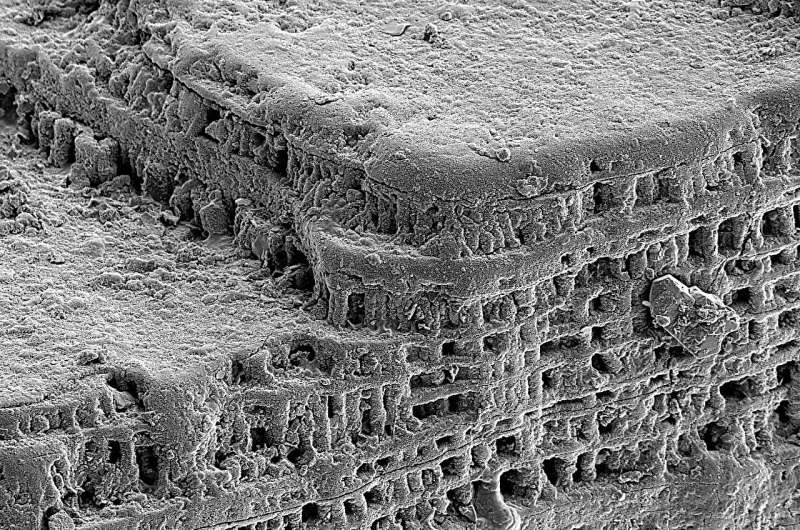
Biomineralized columnar architectures of Cambrian Series 2 phosphatic-shelled brachiopods. Credit: Zhang Zhiliang
Biomineralized columns, stacked in layers like a sandwich gave Cambrian brachiopod shells their strength and flexibility 520 million years ago.
To gain insights into the evolution and diversity of this intricate biomineralized columnar architecture, Dr. Zhang Zhiliang from the Nanjing Institute of Geology and Paleontology of the Chinese Academy of Sciences, together with collaborators from China and Sweden, examined exquisitely well-preserved fossils of some of the oldest families of linguliform brachiopods, providing new fossil evidence for understanding the biomineralization process and adaptive evolution of the ancestral brachiopod taxa of the Early Cambrian.
The study was published in eLife.
The Cambrian, a geological period about half a billion years ago, witnessed one of the most intense bursts of animal evolution in Earth’s history. During this time, most of the groups of marine animals that we would recognize in the oceans today emerged and diversified around the globe. One of the key advances during this explosion of life was the development of biomineralized shells.
Biomineralization, which refers to the biomineralization that produces organic-inorganic composite skeletons and shells, is a process that alters the nature of the Earth’s fossil record by associating living soft organic tissues with solid Earth minerals.
Scanning electron microscopy image of biomineralized columnar architectures and the underlying epithelial cells in early Cambrian brachiopod fossils. Credit: Zhang Zhiliang
Brachiopods, known as “lamp shells,” are one of the most successful biomineralized animal groups, having survived for over 500 million years. Most animal groups only have the ability to secrete only one mineral, but brachiopods are unique animals in that they have the ability to secrete two different minerals, calcium phosphate and calcium carbonate.
Although many living brachiopod species have calcium carbonate shells, the calcium phosphatic linguliform brachiopods were one of the earliest shell-bearing animal groups to appear in the fossil record. Linguliform brachiopod shells generally consist of an organic matrix combined with calcium phosphate (apatite) minerals. Linguliform shells are intricately composed of microscopic cylindrical columns, but the development and role of these microscopic columns in brachiopod evolution is unclear.
In this study, the fossil samples, including Eoobolidae, Lingulellotretidae and Acrotretidae, were collected from the Cambrian Series 2 Shuijingtuo Formation of southern Shaanxi and western Hubei in southern China—a region that is widely considered to be one of the centers for the origin and early distribution of linguliform brachiopods.
The researchers showed that the microscopic columns were stacked on top of each other to form a secondary layer of the shell, in what the researchers called a “stacked sandwich model” (because of the resemblance to the cross-section of a sandwich). This stacked sandwich columnar architecture increases the shell’s toughness, flexibility, and ability to resist fracture by filling the space in between the columns with organic material—similar to the columns of reinforced concrete often used in building construction.
“Thus, we hypothesize that this efficient and economical shell architecture has likely played an important role in the evolution of linguliform brachiopods,” said Zhang, “it may account for the flourishing of phosphatic-shelled acrotretides in the latter half of the Cambrian, and the continued diversification of brachiopods during the Great Biodiversification Event 50 million years later.”
More information:
Zhiliang Zhang et al, Evolution and diversity of biomineralized columnar architecture in early Cambrian phosphatic-shelled brachiopods, eLife (2024). DOI: 10.7554/eLife.88855.4
Journal information:
eLife
Citation:
Scientists construct organo-phosphatic shells of brachiopods (2024, April 18)
retrieved 18 April 2024
from https://phys.org/news/2024-04-scientists-organo-phosphatic-shells-brachiopods.html
This document is subject to copyright. Apart from any fair dealing for the purpose of private study or research, no
part may be reproduced without the written permission. The content is provided for information purposes only.
>>> Read full article>>>
Copyright for syndicated content belongs to the linked Source : Phys.org – https://phys.org/news/2024-04-scientists-organo-phosphatic-shells-brachiopods.html
